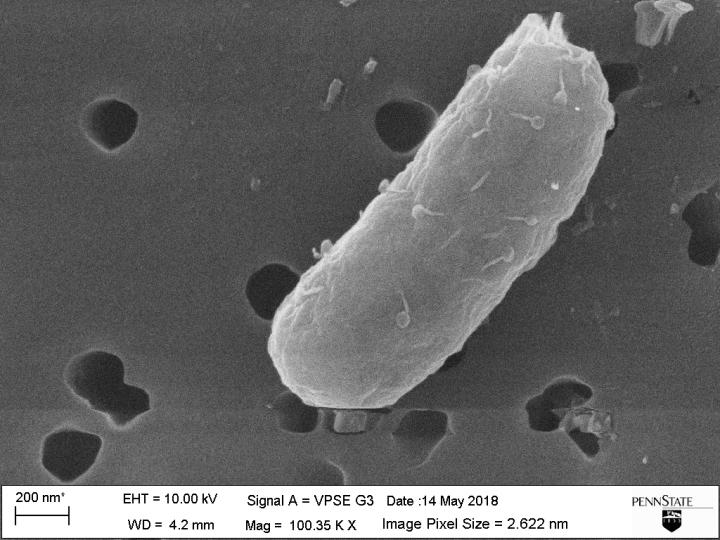
Credit: Sooyeon Song and Missy Hazen/Penn State
Bacterial cells use both a virus — traditionally thought to be an enemy — and a prehistoric viral protein to kill other bacteria that competes with it for food according to an international team of researchers who believe this has potential implications for future infectious disease treatment.
The team, led by Thomas Wood, holder of the biotechnology endowed chair and professor of chemical engineering, Penn State, noticed a gap between two kinds of bacterial cells as they moved on agar plates toward each other, in a form of motility known as “swimming” where the bacterium moves by rotating its flagella.
“It was kind of like when Alexander Fleming noticing bacteria did not grow near a fungus when he discovered penicillin in the 1920s,” Wood said. “We then investigated and found the gap was caused by cells being killed by a virus, SW1, that was carried by only one of the strains.”
The team not only found that a bacterial cell uses the SW1 virus to kill bacteria that are its competitors for food, they also discovered that bacteria that carry the virus are more fit and not killed as often as bacteria without the virus. In addition, they found that for a bacterium to be able to use SW1, it needs a protein fossil of a bacterium that came from another virus millions of years ago. They report their results in a recent issue of Cell Reports.
Wood explained that sometimes a virus will enter a cell and hide in the chromosome until it is ready to attack and kill the cell. However, due to random mutations, a virus sometimes is stuck in the chromosome and cannot leave to attack. There are nine viruses trapped in this way in the beneficial gut bacterium E. coli. To be activated and used by E. coli against other bacteria, the virus SW1 needs a protein, YfdM, from a virus that became caught in the E. coli chromosome millions of years ago.
In addition, the virus is used by the bacterium as an identifier.
“Bacteria are frequently thought of as living alone but instead they can forage for food as groups. In order to act as a group, they must be able to distinguish themselves from other bacteria,” Wood said. “In one type of social activity, bacterial cells secrete chemical signals to communicate. But now, we show that bacterium cells use viruses to distinguish themselves from closely-related bacteria.”
If the bacterium does not detect the virus in the other bacterium, it identifies a competitor for food, and unleashes the virus to kill its competition. While the exact workings of this process are not yet understood, it may hold potential benefits for research and medicine.
“Understanding how cells compete is important,” Wood said. “For example, in synthetic biology where many cells work together, you can make just the cells you want to work for you become dominant. In medicine, you can devise better ways to fight infectious agents.”
###
Along with Wood, the project’s other researchers include Sooyeon Song, chemical engineering postdoctoral researcher, Penn State; Yunxue Guo and Xiaoxue Wang, research scientists with CAS Key Laboratory of Tropical Marine Bio-resources and Ecology, South China Sea Institute of Oceanology, Chinese Academy of Sciences; and Jun-Seob Kim, principal investigator at Korea Research Institute of Bioscience and Biotechnology.
The United States Army Research Office, the Biotechnology Endowed Professorship at Penn State, the National Key R&D Program of China and the Korea Research Institute of Bioscience and Biotechnology Initiative Research Program supported this work.
Media Contact
A’ndrea Elyse Messer
[email protected]




